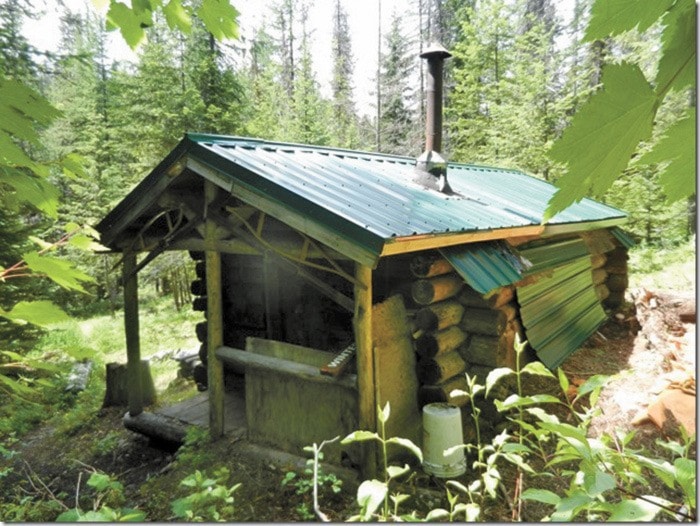By Dave White
Eighty years ago a handful of Kimberley men fulfilled a vision…the building of a cabin halfway between Myrtle Mountain and the Matthew Creek/St. Mary road area.
Back in the day, Tom Hulland, Bob Mulligan, Bob Green and others including an “engineer and project foreman”, packed in supplies and their “Arm-Strong hand tools” to a “sunny, dry location close to a small stream.” And, in 1935, the cabin’s first iteration rose from the ground.
The Half-Way Ski Cabin now is enjoying a renaissance with another restoration — a respite in the forest for hikers, skiers and others who find their way to the Horse Barn Valley and Dipper Lake spaces. It’s a cabin that has served generations of Kimberley residents so well…a cabin with a fascinating and storied past.
Kimberley’s Brian McKenzie is a major push behind this summer’s restoration project.
“I’m involved because as a kid growing up in Kimberley, we used to head out to the cabin on our hikes. I recognized then, from the names and dates scribed on the cabin’s logs, that this had been a significant part of Kimberley’s heritage for many generations,” exclaimed McKenzie.
The original cabin sat with an earthen floor. A year or so after construction, the Fabro Lumber Company, while logging in the area, used the cabin as one of its camps, and at the same time installed the first floor using mostly 3 by 14 inch wooden planks.
Later, supporting beams affected by moisture and time, and the original roof, made of hand-hewn cedar shakes, collapsed, leading to the cabin’s first restoration in 1994.
Sepp Gaskell, who helped pioneer the original Kimberley Nature Park trails network, donated the McLary Furnacette stove installed during the 1990s. The stove, however, only can be used during the winter months. It’s chained shut during the summer to prevent any forest fire incidents.
“In the 90s, we’d go to the cabin, mainly in winter. But by then it had fallen into significant disrepair — the roof off, no door, no porch…,” McKenzie lamented.
“So, with the help of a few parents and their teenage sons we replaced the roof, built a door, reversed the floor planks – good side up, cut in another window, installed bunks, a vandal-proof table, and a stove and chimney.
“Since then ours and many other kids in the community have spent many nights there, either on their own or through the outdoor education and Boy Scout programs.”
Small bits of maintenance happened over the next few years. Firewood would magically appear on the porch, thanks to local outdoor enthusiasts; chimney caps and chimneys would burn out and would be replaced.
The cabin stands as a sentinel to Kimberley’s past…in Horse Barn Valley Interpretive Forest managed co-operatively by Recreation Sites and Trails, Ministry of Forests, Lands and National Resource Operations, British Columbia and Kimberley’s Nature Park Society. These groups are supporting this refurbishing.
Unfortunately, time again has taken its toll, but the Half-Way Ski Cabin is a heritage landmark to be preserved.
The work on the 80-year-old structure this year involves a roofing upgrade from the 20-year-old asphalt rolled-roofing to a more permanent and more fireproof metal roof.
Other fixes will include putting a metal barrier on the back side of the cabin to prevent rotting of the lower logs. Additionally, some parts of the log chinking may be beefed up to deter the local packrat.
Many people have participated in this restoration, including provincial government employees contributing their time on ‘Public Service Day.’
Some ‘volunteers’ packed in materials, supplies, helped clear decades of ingrown bush, assisted in the installation of the new roof and packed out trash.
Another group cleared and excavated dirt, and installed an outdoor biffy, adding to the ‘public conveniences’ in Horse Barn Valley.
These projects are a celebration of cross-agency collaboration and also an opportunity for provincial government employees to give back to the community and the volunteers that manage and maintain the interpretive forest throughout the year.
“One of the goals in the management agreement for the Kimberley Nature Park is to, ‘Preserve the Cultural Heritage,’” McKenzie said.
“Having amenities such as the Half-Way Cabin give our kids alternatives to sitting in front of a screen,” McKenzie enthused. “For kids who have the opportunity to ski in and overnight in a relatively safe and comfortable setting, it can set the stage for a lifetime of appreciation of the natural wonders that are really the ‘stars’ of this valley.”
For visitors to the Kimberley area, the Half-Way Cabin is an amenity that gives a bit of the flavor of how the Kimberley area has evolved.
“According to one of the old log books, the cabin and stove saved a lost visitor from a night in the elements. To me, the Half-Way Cabin is a link with a past that defined fun in simpler ways,” McKenzie intoned.
“No question about it. The Half-Way Ski Cabin is a Kimberley gem we have to keep!”
Dave White is a Kimberley writer and journalist.
